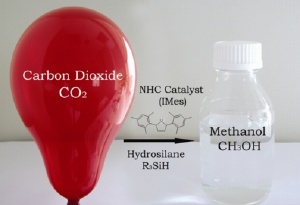Apr 16 2009
Scientists at the Institute of Bioengineering and Nanotechnology (IBN) have succeeded in unlocking the potential of carbon dioxide - a common greenhouse gas - by converting it into a more useful product. Using organocatalysts, the IBN researchers activated carbon dioxide in a mild and non-toxic process to produce methanol, a widely used industrial feedstock and clean-burning biofuel.
 IBN Scientists Convert Carbon Dioxide into Methanol.
IBN Scientists Convert Carbon Dioxide into Methanol.
IBN Researchers First to Transform Carbon Dioxide into Methanol - ‘Very Important’ Paper in Top Chemistry Journal Describes Green Method for Sequestra Singapore | Posted on April 15th, 2009 Published recently in leading international chemistry journal Angewandte Chemie,1 IBN's report has been designated a ‘Hot Paper.' In addition, the Institute's findings have been determined by reviewers to be "very important" - a recognition provided to less than 10% of the journal's manuscripts.
IBN scientists have made carbon dioxide react by using N-heterocyclic carbenes (NHCs), a novel organocatalyst. In contrast to heavy metal catalysts that contain toxic and unstable components, NHCs are stable, even in the presence of oxygen. Hence, the reaction with NHCs and carbon dioxide can take place under mild conditions in dry air. IBN's research shows that only a small amount of NHC is required to induce carbon dioxide activity in a reaction. "NHCs have shown tremendous potential for activating and fixing carbon dioxide. Our work can contribute towards transforming excess carbon dioxide in the environment into useful products such as methanol," shared Ms Siti Nurhanna Riduan, IBN Senior Lab Officer, who is also pursuing her Ph.D. at IBN under the Scientific Staff Development Award.
Hydrosilane, a combination of silica and hydrogen, is added to the NHC-activated carbon dioxide, and the product of this reaction is transformed into methanol by adding water through hydrolysis. Dr Yugen Zhang, IBN Team Leader and Principal Research Scientist, explains, "Hydrosilane provides hydrogen, which bonds with carbon dioxide in a reduction reaction. This carbon dioxide reduction is efficiently catalyzed by NHCs even at room temperature. Methanol can be easily obtained from the product of the carbon dioxide reaction. Our previous research on NHCs has demonstrated their multiple applications as powerful antioxidants to fight degenerative diseases,2 and as effective catalysts to transform sugars into an alternative energy source.3 We have now shown that NHCs can also be applied successfully to the conversion of carbon dioxide into methanol, helping to unleash the potential of this highly abundant gas."
Previous attempts to reduce carbon dioxide to more useful products have required more energy input and a much longer reaction time. They also require transition metal catalysts, which are both unstable in oxygen and expensive. Ongoing research at IBN aims to find cheap alternatives for the hydrosilane reagent so that the production of methanol can be even more cost-effective for mass industrial production.
"At IBN, we are innovating effective methods of generating clean energy using green chemistry and nanotechnology. In the face of environmental pollution, global warming and increasing demands on diminishing fossil fuel resources, we hope to provide a viable alternative energy option for industry, and effective sequestration and conversion of carbon dioxide." said Professor Jackie Y. Ying, IBN Executive Director.
- Angewandte Chemie International Edition, DOI: 10.1002/anie.200806058
- L. Zhao, C. Zhang, L. Zhuo, Y. Zhang and J. Y. Ying, "Imidazolium Salts: A Mild Reducing and Antioxidative Reagent," Journal of the American Chemical Society, 130 (2008) 12586- 12587.
- G. Yong, Y. Zhang and J. Y. Ying, "Efficient Catalytic System for the Selective Production of 5-Hydroxymethylfurfural from Glucose and Fructose," Angewandte Chemie International Edition, 47 (2008) 9345-9348.